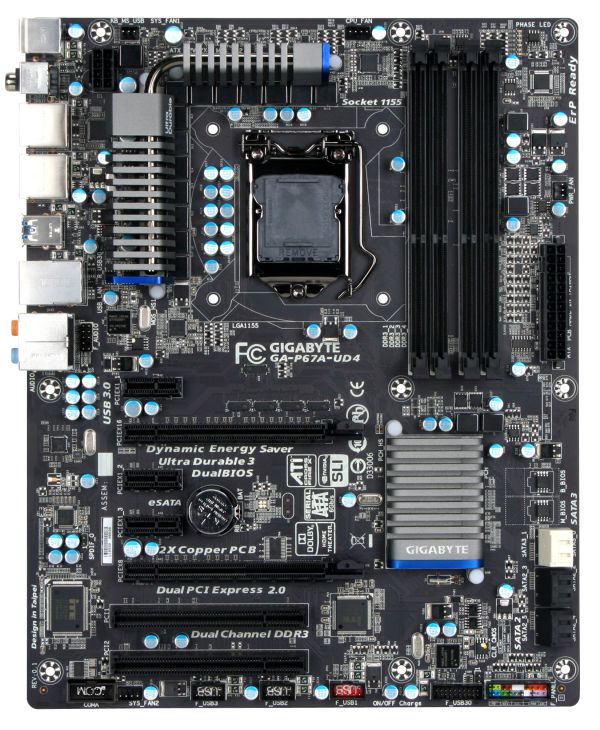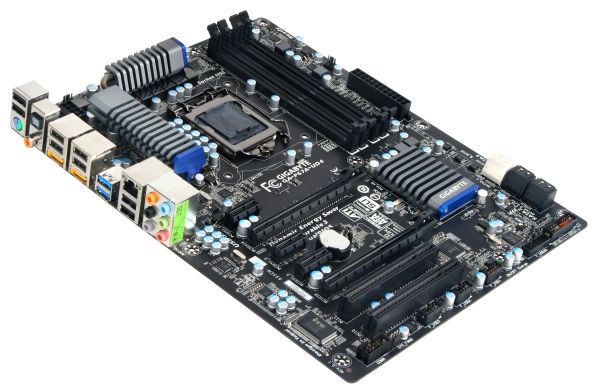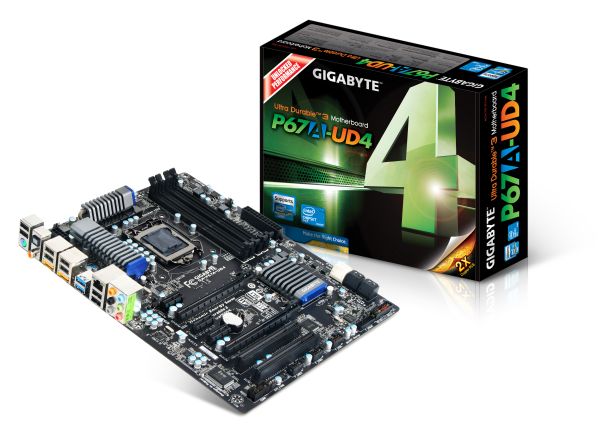The Battle of the P67 Boards - ASUS vs. Gigabyte at $190
by Ian Cutress on January 20, 2011 4:15 PM EST- Posted in
- Motherboards
- Gigabyte
- Asus
- P67
Gigabyte has five P67 motherboards up for the US Sandy Bridge release – the P67A-UD3, the P67A-UD3P, the P67A-UD4, the P67A-UD5 and the P67A-UD7. At least the naming scheme is as easy to follow as previous generations – the higher the last number, the more expensive the board and the more features on offer:
| P67A Series | |||||
| P67A-UD3 | P67A-UD3P | P67A-UD4 | P67A-UD5 | P67A-UD7 | |
| Price | $130 | $160 | $190 | $260 | $320 |
|
SATA 6 Gb/s SATA 3 Gb/s eSATA |
2 4 0 |
2 4 0 |
2 4 2 |
2 4 2 |
4 4 2 |
|
CrossFireX SLI |
Yes No |
Yes No |
Yes Yes |
Yes Yes |
Yes Yes |
|
USB 3.0 USB 2.0 |
2 12 |
4 14 |
4 14 |
8 10 |
10 8 |
| LAN | 1 | 1 | 1 | 1 | 2 |
| PCIe |
2 x16 (1 x16, 1 x4) |
2 x16 (1 x16, 1 x4) |
2 x16 (2 x8) |
3 x16 (2 x8, 1 x4) |
4 x16 (2 x16 or 4 x8) |
Visual Inspection
One of the first things I noticed about the P67A-UD4 was that it was not blue and white, like the majority of the Gigabyte motherboards have been recently that I have worked with. Predominantly featuring a black PCB, black PCIe connectors, black DIMM slots, black SATA 3Gb/s ports, a splash of white for SATA 6GB/s, silver chipset/FET coolers and a hint of old Gigabyte blue on those coolers is what we get this iteration. Not the whole range is like this – I have a H67 Gigabyte board on my desk here and that retains the blue and white credentials, as does the P67A-UD3.
The PCIe layout is slightly different to other P67 boards I have reviewed – with only two PCIe x16 slots (going to x8/x8 in dual GPU mode), there is an extra PCIe x1 slot on the board. In a dual GPU setup, this leaves two PCIe x1 and a PCI slot still free on the board, as well as a gap between dual slot GPUs to aid in cooling.
Fan headers on the board are located near the 8-pin power connector, one above the socket, one above the 24-pin power connector, and one below the PCIe slots, which would only be covered if you have a dual slot PCI card.
Gigabyte’s dual BIOS system is on this board. Yes, that is right – BIOS. No UEFI here. Well, that's not strictly true, as one of the latest BIOS updates at the time of writing (F6) implements an EFI into the BIOS, reportedly allowing bootable access to hard drives over 2.2TB. This is due to, as Gigabyte explained, that their board is actually UEFI, but without a proper GUI interface like other boards. They've used the old BIOS-style interface for now, as after years of plugging away they believe it's quick, stable and recognisable for consumers to understand. So underneath, it's truly 64-bit, meaning 2.2TB+ partition support is possible, and could also suggest that a new GUI is coming in the future. I asked about time-scale for this, but Gigabyte were undoubtedly tight-lipped about dates and implementations.
Visually, in terms of the board, there is not much else to say – the space between the socket and the PCI slots is virtually clear. There are no power, reset or clear CMOS buttons on board, neither is there a debug LED, and which is a real shame given that ASRock can do it on a $150 motherboard. Compared to the ASUS board, all the energy saving and turbo performance options are all software based – no easy flick of switches here.
Like the other P67 boards, the back panel is regular as well. Only a single PS/2 connector, 8 USB 2.0 ports, 2 USB 3.0 ports, 2 eSATA ports, S/PDIF Out connectors, a single gigabit Ethernet, and audio I/O.














137 Comments
View All Comments
IanCutress - Thursday, January 20, 2011 - link
Edited; simple copy/paste error. Glad you liked the review, we should have some H67 on the way next.Ian
Shadowmaster625 - Thursday, January 20, 2011 - link
May as well go down to detroit and buy a big fat rock. I would like to see you guys put together two $600 systems. One based on these outrageous $200 motherboards and a $200 cpu, and $200 for everything else. And put that up against a $70 motherboard and $200 cpu and put the extra $130 into a video card. Who in their right mind would choose this new crap? Dont even talk about encoding because encoding is something you start and then walk away. You dont need to be there to watch it encode so it dont matter how long it takes. (For 95% of users. Dont play these 5 percent mindgames.)vol7ron - Thursday, January 20, 2011 - link
I never walk away from my boxmarc1000 - Friday, January 21, 2011 - link
this is off-topic, but i think you should walk away from your box a little more. =DHrel - Thursday, January 20, 2011 - link
I agree anything over 150 for a motherboard is stupid. But these new Sandy Bridge CPU's are great! It's called progress, and when you do a lot of encoding speed does matter even if you do walk away and/or use another computer in the mean time. Not to mention how intensive encoding full 1080p content is, what about 3D and in the future 4K HD and 8K HD. It's called progress and it's a good thing!Shadowmaster625 - Monday, January 24, 2011 - link
If you do a LOT of encoding, then you will have 2, 3, or 4 machines stacked up next to each other. And those machines would have Athlon X4's and cost $200 apiece to build. Only a fool spends $200, $300, or more, on a cpu just to encode something a little bit faster. You can get much better overall throughput using cheap AMD processors from the last generation. That fact holds true whether you encode one hour a week of video, or 1000. Intel is simply hoping that people are dumber than they may or may not really be.Fatchap - Friday, January 21, 2011 - link
I used to type the command to load up a game or an application, press play on the tape player and walk away. I guess you still do the same as you would not want any of this new crap.Shadowmaster625 - Monday, January 24, 2011 - link
You are quite delusional and propagandized if you think comparing a 2600K to something like a Q6600 or X2-250 is like going from "tape players" whatever you might use now. If you want a proper comparison, try VHS vs SuperVHS. Remember that? Oh yes, you must go out and spend $300 on that shiny new super-vhs player. All your old tapes will still look the same. But that's ok because anything new you record will look pretty good. (Of course if you ever stopped and thought about it, back in the day things always looked pretty good when you first recorded them. It's not until you tried playing it back in a different vcr that it started looking bad.)When someone can build a $500 gaming system that runs faster than something with a previous generation cpu and motherboard for less money then I might begin to be interested. But when you have to go with half the stream processors just to pay for a bunch of new crap that doesnt even get you anything, it makes no sense. These chips are supposed to result in cheaper motherboards. More integration, lesss complexity, bla bla bla. Well I dont see it. I just see a money grab.
seamusmc - Friday, January 21, 2011 - link
Shadow, some of us are still a generation or two behind. We'll definitely see more then a 5 percent boost. Personally I've been waiting for this 'perfect storm' of price and performance for quite some time, though I may wait for the 22nm refresh.Sure if you have an X58 platform with a 950 it probably doesn't make sense to upgrade, certainly not for gaming. Though many of the folks that frequent this site are enthusiasts and just want to play with the new hardware regardless of cost.
seamusmc - Friday, January 21, 2011 - link
Shadow, just realized the 5 percent gain you were talking about may have been between a $70 P67 board and $200 P67 board.I'd agree on that front. Though the more expensive boards do come with more features, USB hubs, and some better quality components.